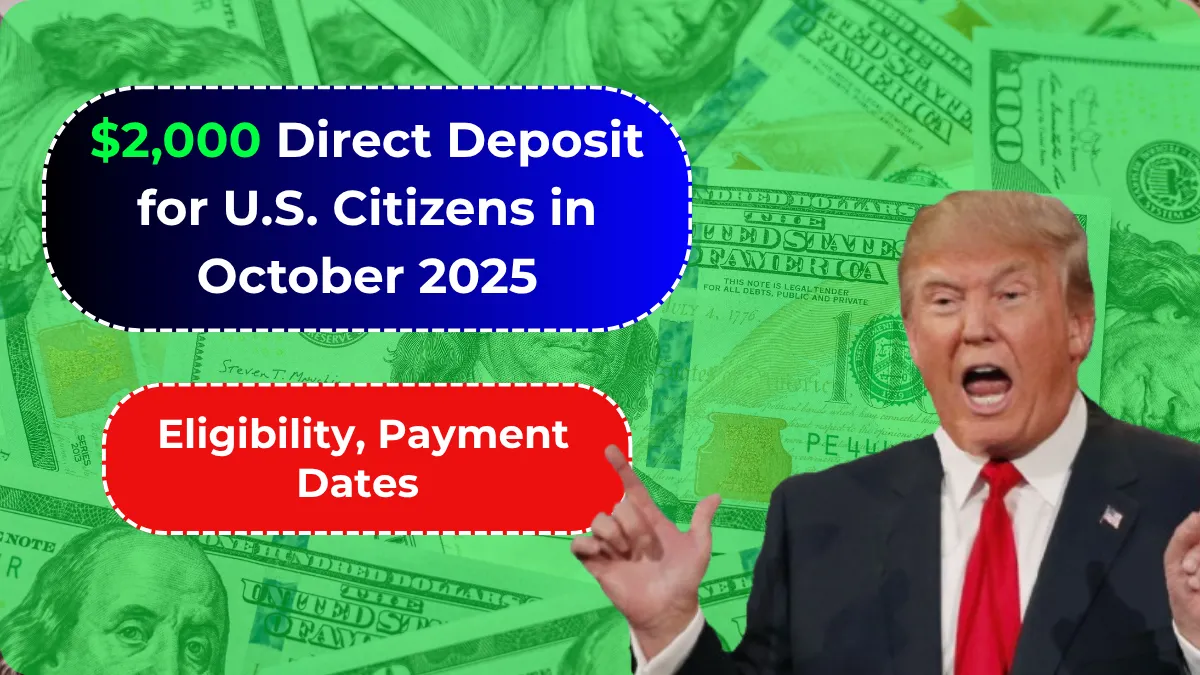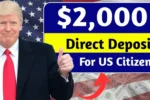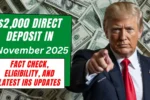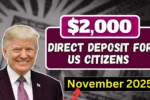As 2025 comes to a close, millions of Americans are about to get a bit of unexpected good news: an extra $2,000 straight into their bank accounts. With grocery prices still sky-high, rent continuing to climb, and everyday expenses adding up, this new round of government relief couldn’t come at a better time. The IRS, working with the U.S. Department of the Treasury, is set to roll out these payments in November—just in time to give families a much-needed financial cushion before the holidays hit.
This isn’t just another government check; it’s a chance to catch a breath.
What’s the $2,000 Direct Deposit All About?
Simply put, it’s a one-time, tax-free payment designed to help families cope with the ongoing financial strain caused by inflation. Unlike loans or credit-based programs, this money doesn’t need to be paid back, and there are no strings attached. Whether you’re behind on rent, need to stock up on groceries, or just want to set aside a little cash for a rainy day, you can use the funds however you see fit.
Even though the U.S. economy has started to show signs of recovery, the costs of essentials—like food, gas, utilities, and healthcare—are still stubbornly high. This payment is meant to provide working-class and middle-income families with some breathing room while also encouraging local spending in communities across the country.
Who’s Eligible for the $2,000 Payment?
Eligibility is similar to the structure of previous stimulus checks, and the goal is to make sure the money goes to those who need it most. Here’s how it breaks down:
- Single filers: Must have an Adjusted Gross Income (AGI) of $75,000 or less to receive the full $2,000.
- Married couples filing jointly: Must have a combined income of $150,000 or less to qualify for the full payment.
- Heads of household: Eligible if they earn $112,500 or less.
If your income exceeds these thresholds, you may still receive a partial payment, though the amount will gradually decrease as your income rises.
In addition, you must meet these requirements:
- Be a U.S. citizen or lawful permanent resident.
- Have a valid Social Security Number (SSN).
- Have filed a 2024 federal tax return or currently receive benefits from Social Security, SSI, VA, or SSDI.
And if you received any of the pandemic-era stimulus payments, you’re likely eligible again.
$1130 Stimulus Checks 2025: Payment Dates, Requirements and Updates
When Will the Payments Arrive?
The IRS plans to start distributing the $2,000 direct deposits on November 12, 2025, with payments continuing through the end of the month. Here’s the expected timeline:
- Direct Deposit (Nov. 12–25, 2025): For taxpayers with banking info already on file with the IRS.
- Paper Checks (Starting Nov. 25, 2025): For those who don’t have direct deposit set up—expect minor postal delays.
- Prepaid Debit Cards (Late Nov.–Early Dec. 2025): For those who prefer or require a mailed debit card.
Direct deposit is the quickest and safest method, and the IRS will update the “Get My Payment” portal by late November, allowing you to track the status of your funds.
How to Make Sure You Get Your Payment
If you’re eligible, there’s no need to apply. But there are a few steps to ensure the process goes smoothly:
- File your 2024 taxes—even if your income was low or non-taxable.
- Double-check your direct deposit info in your IRS online account.
- Verify your mailing address if you’re expecting a paper check.
- Watch for official IRS updates and avoid scams (the IRS will never ask for personal info via text, email, or phone).
If you already receive Social Security or VA benefits, you don’t need to do anything—the payment will be sent automatically.
How Might People Use Their $2,000 Relief Check?
For many families, this extra $2,000 won’t just be a holiday bonus—it could help cover critical day-to-day expenses. Here are some ways people might use the funds:
- Paying rent or mortgage
- Covering medical bills or insurance costs
- Buying groceries or other household necessities
- Paying off credit card debt
- Building up an emergency savings fund
Imagine being able to catch up on that overdue bill or easing the stress of December’s holiday expenses. That’s exactly what this relief is designed to help with.
Why Is the Government Sending This Payment?
Beyond providing immediate relief, there’s a bigger picture: stimulating the economy. When millions of Americans have extra money to spend, local businesses and small shops see an uptick in sales. This ripple effect helps create jobs and supports local economies—something that’s especially important after years of inflation and financial uncertainty.
An IRS spokesperson summed it up perfectly:
“Our focus is to get timely relief to Americans who need it most. This assistance is about stability and dignity—it helps families close out the year with a little less worry.”
A Boost of Confidence for the Holidays
At its core, the $2,000 payment is more than just a financial transfer; it’s a message of support. It’s the government’s way of saying, “We see you, and we’re here to help.”
For millions of Americans, this payment could mean peace of mind during one of the most expensive times of the year. Whether it’s catching up on bills, buying gifts for loved ones, or simply making it through the month, this relief could be a game-changer.
So, if you’re eligible, keep an eye on your bank account starting mid-November. Relief is closer than you think.
Quick Facts
- Who qualifies for the $2,000 payment?
U.S. citizens earning $75,000 or less (single) or $150,000 or less (married filing jointly) qualify for the full payment. - When will payments start?
Direct deposits will begin on November 12, 2025, with paper checks and debit cards following shortly after. - Is the payment taxable?
No. The $2,000 is tax-free and won’t affect your tax refund or other benefits. - Do I need to apply?
No application is needed. Payments will be sent automatically to eligible individuals. - How can I track my payment?
You can use the IRS “Get My Payment” tool once it goes live in mid-November 2025.





